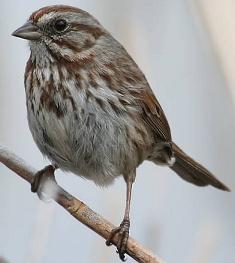Song Sparrow 
Identification and Pictures
(Melospiza melodia)
 Song sparrows are 5 to 7 inches.
They have a light brown head
with a white streak that runs from the beak over the top
of the eye to the back of the head. Their brown bill is
short for a sparrow. The adults
have a streaked breast with a black spot in the center.
They have a long, rounded tail, which they hold cocked up, and pump
up and down, as they dart around with their short
fluttering flight. Song sparrows are 5 to 7 inches.
They have a light brown head
with a white streak that runs from the beak over the top
of the eye to the back of the head. Their brown bill is
short for a sparrow. The adults
have a streaked breast with a black spot in the center.
They have a long, rounded tail, which they hold cocked up, and pump
up and down, as they dart around with their short
fluttering flight.
Young birds have finer steaks, and may not have the spot.
There are many subspecies with variations from one area to another.
Photos by Keith Lee.
The camera I use is the Canon
EOS 40D. Visit All-birds store
Range and Habitat
 Song
sparrows range across North
America. Birds in northern ranges may migrate to
southern U.S. and Mexico, others are resident year
round. They like open areas, marshes, thickets, shrubs
around field edges, and backyards. They may be seen
flitting through low branches, and vegetation, or hopping,
and running on the ground. Song sparrows are solitary birds
during breeding season, but they may be found in small
flocks with other birds such as House
sparrows in winter. Song
sparrows range across North
America. Birds in northern ranges may migrate to
southern U.S. and Mexico, others are resident year
round. They like open areas, marshes, thickets, shrubs
around field edges, and backyards. They may be seen
flitting through low branches, and vegetation, or hopping,
and running on the ground. Song sparrows are solitary birds
during breeding season, but they may be found in small
flocks with other birds such as House
sparrows in winter.
Breeding and Nesting
Song sparrows are very territorial, and
males defend their territories with chases and
fights. Although Song sparrows are
territorial they often build their nests in close
proximity to each other. They are usually
monogamous. They build their nest on the
ground, in a bush, or in grass. The female builds
the nest of grass, leaves, weeds, and bark, and lines it
with
grass, hair, and rootlets. She will incubate 3 to 5
greenish white eggs with dark marks for 10 to 14
days. Both parents will feed the
young a diet of mostly insects. The young birds
will leave the nest within 2 weeks, but they will stay
around the parents for 3 more weeks. The birds may
have several broods in a year.
Song and Call
Song sparrows will sing a series of notes
that vary from musical to a buzzy sound. Males may
have up to 10 different songs, repeating one several
times before switching to another. They will perch
in a bush or tree as they sing. A high tic sound
is an alarm call. Listen to
Song Sparrow
Food and Feeding
Natural foods for sparrows are insects, seeds,
and berries, which they forage for in shrubs, and on the
ground.
For more
on food and feeding click here.
For more on feeders click here.
To learn about other
favorite birds click here.

|
|
|
 All-birds Store
All-birds Store
Bird Watching guides, books, binoculars,
cameras, gifts for bird lovers, bird baths, feeders
and more... baths, feeders
and more...
|
|
|
RECOMMENDED READING
Available for Immediate
Download

Click
here
|
|
